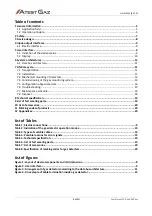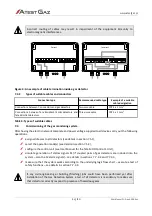
www.atestgaz.pl
detectors must not be exposed to direct effect of water (moisture) or other chemicals (e.g.
cleaning chemicals when the facilities are being cleaned), as well as to direct effect of sunlight,
rain or wind,
detectors must be secured against damaging mechanical impacts,
locations of detectors must enable easy checks and adjustments as well as replacement or
disconnection of each detector.
7.3
Mechanical mounting of detectors
Mounting of gas detector is allowed only after full completion of all civil engineering works.
Spring clamps of terminal blocks are released by depression of the button with a screwdriver.
Detectors must be fixed by means of mounting holes that are visible after opening of the housing.
Make sure that the gas inlet looks downwards. Dimensions of the housing, arrangement of
mounting holes and layout of internal components is shown in Figure 1. Drilling of mounting holes
in walls or other permanent structures is easier with use of a drilling pattern attached to the
device package.
7.3.1
Electric network
The electric network must be deployed according to the engineering documentation.
The electric system must be designed in conformity to general rules for engineering of A&C
systems.
Electric cables and conductors shall be routed in a safe manner to have then protected
against possible damage.
If stranded cables are used for deployment of electric lines, ends of cable cores in such cables must be
secured by means of clamping bushings (lug).
When two conductors are to be connected to a single terminal clamp of the device they must be
encapsulated first within a common clamping bushing (lug) – see details in Table 5.
Do never leave spare lengths of cables inside the device. Bare wires or wires surplus may
lead to a hazard of electric shock or equipment damage.
Do never leave redundant cable cores not terminated inside the device.
3
Automation and Control Systems
s. 12|20
User Manual: POD-046-ENG R01













































